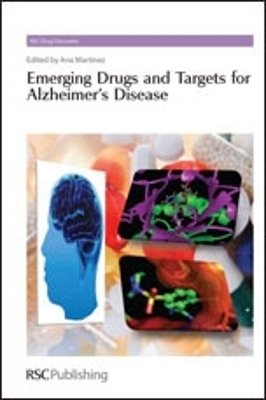
Emerging Drugs and Targets for Alzheimer's Disease
Royal Society of Chemistry
978-1-84973-045-7 (ISBN)
- Titel ist leider vergriffen;
keine Neuauflage - Artikel merken
Alzheimer's disease (AD) is the most prevalent neurodegenerative disorder in the elderly. The Bloomberg School of Public Health recently estimated that over 26 million people were living with AD in 2006 and that the number will grow to 106 million by 2050. Interventions that delay onset by just one year could reduce the 2050 figure by 12 million. This demonstrates the importance and social need of finding an effective therapeutic intervention.
Both volumes gather together some of the most promising examples of drugs now in pharmaceutical development, and new targets currently going through a validation process. It describes the discovery and development history of the disease modifying therapeutics most likely to reach the Alzheimer's market in the next few years. It is of interest to both those working in the pharmaceutical industry and in academia from graduate level onwards.
Ana Martinez obtained her PhD in Organic Chemistry from the Complutense University of Madrid before becoming a researcher at the Medicinal Chemistry Institute of the Spanish National Council for Research (CSIC). Since 1995, her interests have focused on neurodegenerative disorders and she has led numerous research projects on the medicinal chemistry and rational drug design with the aim of finding new treatments for Alzheimer's disease. In February 2002, she joined NeuroPharma (now NOSCIRA) as R&D Director where she led projects from the discovery of potential new therapies to the final proof of concept in animal models. In February 2008, she returned to her academic position at the Medicinal Chemistry Institute (CSIC) leading several projects on neurodegenerative disease therapies and acting as an external scientific advisor to a number of pharmaceutical companies. Her main areas of research currently involve GSK-3 inhibitors and dual binding site acetylcholinesterase inhibitors. She has authored over a hundred and fifty scientific publications and has more than twenty active patents in the field.
VOLUME 1; Beta-Amyloid as target; Chapter 1: The amyloid hypothesis of AD and prospects for therapeutics; Chapter 2:Targeting Alzheimer's ?-Secretase: Genetic and Chemical Modulation; Chapter 3: Cholesterol and AD: the molecules, the targets; Chapter 4: The Bimodal Features of Butyrylcholinesterase in Cholinergic Neurotransmission and Amyloid Suppression; Chapter 5: Scyllo-inositol, a potential therapy for Alzheimer's disease; Chapter 6: Immunotherapeutic strategies toward treatment of AD; Tau protein as target; Chapter 7: Alzheimer Neurofibrillary Degeneration: Pivotal Role and Therapeutic Targets; Chapter 8: Multiple roles of glycogen synthase kinase-3 in AD; Chapter 9: Tau protein kinases inhibitors: from the bench to the clinical trials; Chapter 10: Activating PP2A as a therapeutic intervention strategy in AD; Chapter 11: Rationale for tau aggregation inhibitor therapy in Alzheimer's disease and other tauopathies; Glucose Metabolism as target; Chapter 12: Insulin Insulin Resistance and neurodegeneration: Type 2 versus type 3 diabetes mellitus; Chapter 13: Insulin-like Growth Factor I as a disease-modifying therapy in Alzheimer¦s disease; Chapter 14: Ketone bodies as a therapeutic for Alzheimer¦s disease; VOLUME 2 Neuronal Plasticity as target; Chapter 15: Regeneration of Degenerated Brain: A Promising Therapeutic Target; Chapter 16: Promoting synaptic resilience in AD patients through PDE inhibition; Chapter 17: A new generation of non invasive NGF-based therapies for Alzheimer's disease; Chapter 18: Possible clinical applications of stem cell strategies in AD therapies; Neuronal protection as target; Chapter 19: Targeting Oxidative Mechanisms in Alzheimer Disease; Chapter 20: Davunetide (NAP) Pharmacology: Neuroprotection and tau; Chapter 21: Targeting NF- B inflammatory and pro-survival signaling in AD; Chapter 22: PPAR in Alzheimer`s disease; Miscellaneous targets and strategies; Chapter 23: Serotonin 5-HT4 receptors as pharmacological targets for the treatment of Alzheimer¦s disease; Chapter 24: Liver X Receptors as potential therapeutic target for AD; Chapter 25: Discovery of memoquin, a multi-target-directed ligand for the treatment of Alzheimer's disease Chapter 26. RNA interference of genes related to AD B. Nawrot Chapter 27. Medicinal plants, phytochemicals and Alzheimer's Disease D. Kennedy
| Erscheint lt. Verlag | 7.5.2010 |
|---|---|
| Reihe/Serie | Drug Discovery |
| Zusatzinfo | Not illustrated |
| Verlagsort | Cambridge |
| Sprache | englisch |
| Maße | 156 x 234 mm |
| Themenwelt | Medizin / Pharmazie ► Medizinische Fachgebiete ► Geriatrie |
| Medizin / Pharmazie ► Medizinische Fachgebiete ► Pharmakologie / Pharmakotherapie | |
| ISBN-10 | 1-84973-045-8 / 1849730458 |
| ISBN-13 | 978-1-84973-045-7 / 9781849730457 |
| Zustand | Neuware |
| Informationen gemäß Produktsicherheitsverordnung (GPSR) | |
| Haben Sie eine Frage zum Produkt? |
aus dem Bereich
